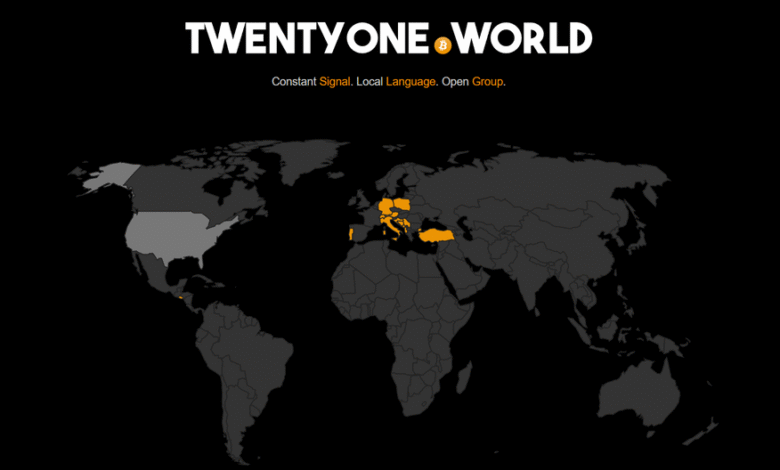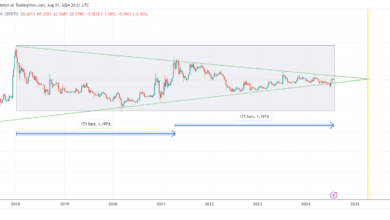Twenty One Bitcoin Investment: A Game Changer for BTC

In the rapidly evolving world of cryptocurrency, **Twenty One Bitcoin Investment** has emerged as a prominent contender, particularly as it seeks to redefine how investors engage with Bitcoin. Founded with the vision to accumulate as much Bitcoin as possible, this ambitious company is grabbing attention, especially with its significant investments aimed at capitalizing on Bitcoin’s price growth. Leading voices like Jack Mallers and Michael Saylor are at the forefront of this movement, providing strategies that have contributed to the meteoric rise of Bitcoin investments. With the price growth witnessed in stocks like Twenty One, mirroring the explosive success stories of companies like MicroStrategy, investors are now curious about its potential return. As more people look to diversify into **Twenty One stock**, understanding the underpinnings of its Bitcoin strategy could hold the key to unlocking substantial profits in this digital gold rush.
When discussing investments in cryptocurrency, **Twenty One Bitcoin Investment** stands out for its strategic approach to Bitcoin acquisition and market positioning. This organization aims to fortify its portfolio by leveraging influential figures in the cryptocurrency space, similar to the strategies executed by notable entities such as MicroStrategy. By harnessing capital efficiently and offering innovative financial products, Twenty One aspires to attract investors eager for the kinds of growth reminiscent of Bitcoin’s historic ascendance. As the performance of the Bitcoin market significantly influences investor sentiment, savvy market participants are keenly observing Twenty One’s evolving narrative against competing firms. Particularly with the executive vision from industry leaders, this venture might just be the next big opportunity for those seeking to align with the ongoing Bitcoin revolution.
Understanding the Market Landscape: Jack Mallers vs. Michael Saylor
The ongoing rivalry between prominent crypto figures like Jack Mallers and Michael Saylor offers a unique lens through which to view the Bitcoin investment landscape. Both individuals are instrumental in pushing the boundaries of institutional investment in Bitcoin, yet their approaches highlight differing strategies within the same overarching goal: maximizing Bitcoin’s potential. Saylor, the CEO of MicroStrategy, has established a significant precedent with his aggressive Bitcoin acquisition strategy, watching his company’s stock soar over 2300% since embracing Bitcoin in 2020. Meanwhile, Mallers, as the CEO of Twenty One, is poised to challenge this dominance with a fresh perspective aimed at generating capital specifically for Bitcoin acquisition, potentially reshaping the market dynamics further.
The competition specifically lies in their contrasting philosophies towards capital efficiency and risk management within Bitcoin holdings. While Saylor’s model has proven fruitful for MicroStrategy, with its massive $92 billion valuation, Mallers emphasizes a more scalable and efficient model that could cater better to new investors entering the Bitcoin space. This strategic dichotomy not only underscores the innovations within the cryptocurrency realm but also strengthens the argument that Bitcoin is fundamentally changing how we perceive investment opportunities in traditional markets.
The Role of Twenty One Bitcoin Investment in the Crypto Economy
Twenty One Bitcoin Investment aims to capitalize on the burgeoning interest in Bitcoin by leveraging its unique capital structure. With a current holding of 31,500 BTC and a commitment to maintaining a high Bitcoiner per share (BPS) ratio, Twenty One is positioned to attract potential investors who are wary of traditional equities. This approach mirrors MicroStrategy’s strategy, which has shown significant success; however, it introduces an innovative twist by promising higher capital efficiency. This differentiation strategy is pivotal as it tries to lure investors interested in the potential exponential growth of Bitcoin’s price, demonstrated by MSTR’s performance over the last few years.
Moreover, by developing financial products grounded in Bitcoin, including future innovations that could replace outdated financial instruments, Twenty One aims to establish itself as a reliable player in the crypto economy. Collaboration possibilities with established entities like Strike, under Mallers’s leadership, could provide additional validation and growth potential for Twenty One. As such, the initiative aligns perfectly with the increasing mainstream acceptance of Bitcoin as a legitimate asset class, positioning Twenty One as a vital player in presenting Bitcoin’s value proposition to a broader audience.
Comparative Analysis: Twenty One vs. MicroStrategy
While comparing Twenty One with MicroStrategy, it is essential to look at the differing market strategies that each company employs. MicroStrategy has effectively leveraged its corporate structure to accumulate vast BTC reserves, significantly influencing its stock price and providing a model that many aspiring Bitcoin investments look to replicate. In contrast, Twenty One is embarking on a different route, focusing on efficiency over sheer volume, which could be a game-changer if executed correctly. Mallers has stated a clear intention to raise as much capital as possible for Bitcoin, which could position Twenty One uniquely in the minds of potential investors.
Another aspect to consider is the risk factor associated with traditional corporate ties versus more decentralized Bitcoin holdings. Investors weighing their options may find that while MicroStrategy has established a track record, the risk of dependency on centralized business decisions remains. Alternatively, Twenty One is seen as a potentially more flexible entity due to its commitment to Bitcoin-centric innovations, which may attract investors seeking maximum exposure to Bitcoin’s price growth without the burden of traditional stock market volatility.
Market Predictions: Will Twenty One Outperform MicroStrategy?
Forecasting whether Twenty One can outperform MicroStrategy requires careful analysis of both current market dynamics and investor sentiment surrounding Bitcoin. Given the notable price surge of MSTR and its substantial Bitcoin holdings, Twenty One’s emergence as a competitor is timely. Investors are increasingly optimistic about Twenty One’s ability to deliver similar, if not superior, returns, especially in light of the strong brand presence of both Jack Mallers and Michael Saylor in the Bitcoin ecosystem. As seen in initial market reactions following Twenty One’s announcement, there is significant speculative interest that could lead to considerable price growth if managed effectively.
Still, potential investors must be cautious. While the excitement surrounding Twenty One presents opportunities, the company must navigate challenges, including distinguishing itself from its competitors and proving its model’s efficacy over time. If it can capitalize on investor sentiment and demonstrate a clear roadmap to harness Bitcoin price growth robustly, Twenty One could very well establish itself not just as a competitor, but as a leader in the Bitcoin investment landscape.
Investor Sentiment and the Future of Bitcoin Stocks
Investor sentiment plays a crucial role in the performance of stocks related to Bitcoin. As Bitcoin continues to garner attention as a viable asset, more investors are drawn to Bitcoin stocks like Twenty One and MicroStrategy. Recent trends suggest a warming appetite for companies that embrace Bitcoin, which is reflected in the significant rises in stock prices post-announcements related to BTC acquisitions. This trend indicates a broader acceptance of cryptocurrency investments in traditional investment portfolios, pushing both new and seasoned investors to consider exposure to Bitcoin-centric companies.
However, sentiment can be fickle, especially in the volatile world of cryptocurrencies. Investors must remain prudent and keep an eye on market conditions, regulatory changes, and individual company performance. As history has shown with Bitcoin’s fluctuating prices, those investing in Bitcoin stocks like Twenty One should maintain a balanced view, understanding the inherent risks while also acknowledging the historical price growth that Bitcoin has exhibited. This dual approach could help investors navigate the complex relationship between Bitcoin and its associated equities.
Twenty One’s Unique Selling Proposition and Market Position
The unique selling proposition of Twenty One lies in its unwavering commitment to Bitcoin acquisition, distinguishing it from competitors like MicroStrategy. By maintaining a higher Bitcoin per share ratio, Twenty One aims to foster deeper investor trust, indicating a clearer alignment between the company’s strategies and the cryptocurrency’s fundamentals. This focus on Bitcoin-centric policies may lure those hesitant to invest in traditional fiscal equities while simultaneously embracing the revolutionary aspects of cryptocurrencies.
Additionally, Twenty One’s forward-thinking approach reflects a broader shift within the financial industry towards integrating Bitcoin into financial products. As the company seeks collaborations with established entities such as Strike, it positions itself not only as an investment hub but also as an innovator in financial technology, further boosting its appeal to potential investors. By clearly outlining a vision to support developments in Bitcoin-oriented alternatives, Twenty One seeks to carve out a significant space in a rapidly evolving market landscape that increasingly favors Bitcoin-centric solutions.
Navigating Risks: Investing in Bitcoin-related Stocks
Venturing into investments related to Bitcoin can be fraught with risks, despite the many rewards. For instance, the volatility associated with Bitcoin prices also extends to stocks like Twenty One and MicroStrategy, both of which rely heavily on the performance of Bitcoin. Investors must remain cognizant of mandatory risk factors, including market regulations, technological advancements, and broader economic conditions that could impact cryptocurrency investments. As excitement builds around Bitcoin-related equities, it is essential to conduct thorough research and understand the nuances of each investment.
Moreover, the dependence on corporate management decisions raises questions about investor control over their fortunes tied to these stocks. Many Bitcoiners argue that the most secure route to Bitcoin investment is holding BTC directly, thus sidestepping the complications associated with corporate governance. Despite this sentiment, those willing to accept the risks associated with Bitcoin stocks might find opportunities to enhance their portfolios, especially when considering the long-term price growth potential that Bitcoin has consistently demonstrated.
Long-Term Potential: Is Twenty One a Smart Investment?
For potential investors considering whether to enter Twenty One, the long-term potential of the company appears promising, especially given the current traction and interest around Bitcoin. As historical trends show, Bitcoin has consistently proven its ability to appreciate, which directly ties to the success of companies whose business models are centered on Bitcoin. The significant price growth experienced by MicroStrategy should serve as a guide illustrating that companies successfully executing Bitcoin strategies can yield remarkable returns.
Given the present trajectory of Twenty One and its strong backing from influential figures like Jack Mallers, the investment might be deemed sensible, particularly for those bullish on Bitcoin’s future. However, investors should remain watchful of market developments and regulatory changes to ensure that their investment aligns with their broader financial strategies, balancing the promise of Bitcoin-related stocks with caution surrounding the inherent risks. This thoughtful consideration will be crucial as the crypto market continues to evolve.
Financial Trends: The Impact of Bitcoin on Traditional Investments
As Bitcoin continues to dominate discussions around digital assets, there’s a growing acknowledgment of its potential to reshape traditional investment paradigms. Companies like Twenty One and MicroStrategy are at the forefront of this shift, introducing BTC as a valuable asset within investment portfolios typically dominated by stocks and bonds. The price growth seen in Bitcoin not only highlights its appeal as a speculative investment but also suggests that it could function as a hedge against inflation — a sentiment increasingly shared among institutional investors.
Investors in traditional markets are beginning to diversify with Bitcoin offerings, treating them not just as speculative assets but as integral components of long-term strategies. As the relationship between Bitcoin price growth and institutional adoption strengthens, the opportunity for companies banking on Bitcoin, like Twenty One, is significant. If strategically managed, these entities can offer investors unique opportunities tied to the emerging trend of cryptocurrencies becoming a staple in diversified investment portfolios.
Frequently Asked Questions
What is Twenty One Bitcoin Investment and how does it compare to Michael Saylor’s strategy?
Twenty One Bitcoin Investment is a company led by CEO Jack Mallers that aims to raise capital to acquire Bitcoin and support Bitcoin-oriented financial products. It is often compared to Michael Saylor’s Bitcoin strategy with MicroStrategy (MSTR), which has significantly benefited from price growth. Unlike MSTR, Twenty One focuses on maximizing Bitcoin per share (BPS) and offers a potentially more capital-efficient approach to Bitcoin acquisition.
How does Jack Mallers’ vision for Twenty One align with Bitcoin price growth?
Jack Mallers, CEO of Twenty One, envisions raising substantial capital for Bitcoin acquisition, leveraging the significant price growth of Bitcoin. The company’s strategy aims to mirror successful models while providing greater capital efficiency. Investors hope that as Bitcoin continues to experience growth, Twenty One can replicate or even surpass the incredible returns seen by MSTR, which has seen over 2,000% price growth since adopting its Bitcoin strategy.
What is the current Bitcoin per share (BPS) status of Twenty One?
Currently, Twenty One holds 31,500 BTC and has approximately 267 million shares outstanding, resulting in a BPS of about 0.00011783 BTC. This metric is crucial for investors looking to understand the company’s positioning within the rapidly evolving Bitcoin market.
Is Twenty One a viable investment option for those following Bitcoin strategies?
Investing in Twenty One might be worthwhile for those interested in Bitcoin strategies, especially considering its significant initial stock price increase of over 50%. However, potential investors should be cautious about the risks associated with centralized authorities, which contrasts with the independent nature of Bitcoin.
What financial products does Twenty One plan to develop around Bitcoin?
Twenty One plans to develop various financial products utilizing Bitcoin, such as credit models and capital market instruments. The goal is to innovate and replace traditional financial instruments with Bitcoin-focused alternatives, further integrating Bitcoin into mainstream finance.
How does the competition between Twenty One and established firms like MicroStrategy affect Bitcoin investments?
The competition between Twenty One and established firms like MicroStrategy enhances investor interest in Bitcoin investments. While MicroStrategy has a significant first-mover advantage, Twenty One aims to offer unique efficiencies and strategies that could attract investors looking for alternatives within the Bitcoin investment space.
What makes Twenty One’s approach to Bitcoin investment distinct?
Twenty One’s approach is distinct due to its commitment to maximizing the Bitcoin held per share, which is designed to attract investors by showcasing a potentially higher capital efficiency compared to larger competitors like MicroStrategy. This focus on strategic Bitcoin acquisition may appeal to those looking for innovative ways to engage with Bitcoin investments.
Are there any potential risks for investors in Twenty One Bitcoin Investment?
Yes, investors in Twenty One should be aware of the potential risks associated with centralized entities and the reliance on the leadership of Jack Mallers and other executives. Unlike direct Bitcoin investments, which are decentralized, investing in companies like Twenty One involves exposure to regulatory risks and management decisions that could impact performance.
| Key Points | |
|---|---|
| Company Vision | Twenty One aims to raise capital to acquire as much Bitcoin as possible, emphasizing Bitcoin per share for investors. |
| Bitcoin Holdings | Twenty One currently holds 31,500 BTC and 267 million shares, equating to a Bitcoin per share (BPS) of 0.00011783 BTC. |
| Strategic Importance | Twenty One plans to support financial products built on Bitcoin, possibly collaborating with the exchange Strike. |
| Market Position | After announcing their Bitcoin strategy, Twenty One’s stock price surged by over 50%. |
| Comparison with MicroStrategy | There is a competitive comparison with MicroStrategy (MSTR), which has seen a 2,300% price increase since launching its strategy. |
| Potential Risks | Investors face risks as both Twenty One and MSTR’s success rely on centralized authorities despite being in the Bitcoin space. |
Summary
Twenty One Bitcoin Investment has emerged as a promising contender in the cryptocurrency space, primarily focused on acquiring substantial Bitcoin holdings. Their innovative approach, combined with the backing of significant financial players, suggests potential for growth akin to that of established companies like MicroStrategy. However, caution is advised due to inherent risks in relying on centralized practices. It’s crucial for investors to weigh the potential rewards against these risks before deciding on their investment strategy.



